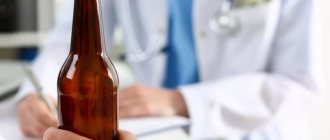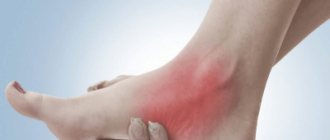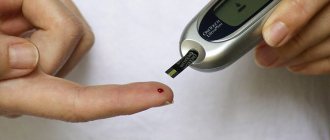To get a consultation
The key to successful rehabilitation in our clinic is targeted action on the affected areas in combination with modern drug therapy.
There is a considerable amount of truth in the hackneyed phrase “All diseases come from nerves.” Polyneuropathy (“disease of many nerves” - Greek) is manifested by many symptoms - from the effect of “running goosebumps” or burning sensation to swelling, sometimes inexplicable attacks of pain, trembling of the limbs, muscle weakness, sweating, shortness of breath, palpitations. Polyneuropathy itself is the result of other diseases, including diabetes, various injuries, and exposure to toxins.
We effectively work with all types of polyneuropathy, preventing its severe consequences - decreased muscle tone, muscle atrophy, loss of a person’s ability to move independently, and self-care.
Given the complexity of this neurological disease, patients require extensive rehabilitation along with basic treatment, which begins with consultation and examination by an experienced neurologist.
After assessing reflexes, muscle tone, limb mobility and analyzing information about concomitant diseases, he will select a personal rehabilitation program for you.
Also, experienced professionals - physical therapy doctors, physiotherapists, massage therapists - will work together with neurologists to solve your health problem.
Using a unique and powerful electroneurophysiological station, specialists will not only conduct an initial diagnosis, but will also evaluate all changes in the functional state of the nervous system during the rehabilitation process. The accuracy of this device is such that not a single slightest deviation in the indicators will escape the attention of our specialists.
In our rehabilitation department, we have collected everything necessary for comprehensive rehabilitation aimed at overcoming polyneuropathy - exercise equipment, walking tracks, modern physiotherapeutic complexes. Along with manual massage, during the rehabilitation of patients with polyneuropathy, modern chivamat therapy (massage with a pulsating electrostatic field), modern computer stations for the functional restoration of the limbs (with biofeedback), installations that simulate the support load of the feet, electromyostimulators, installations for magnetic therapy, etc. .P.
“The key to successful recovery from polyneuropathy is continuous, comprehensive rehabilitation with the construction of an individual program under the supervision of a team of professionals.”
— Alexey Alekseevich Kudryashov, head of the neurology department.
Symptoms of drug-induced polyneuropathy
A burning sensation and numbness in the feet appear some time after the start of drug treatment (weeks, months) (90%). There is a feeling of tingling, “crawling goosebumps”, coldness and chilliness in the feet (50%). Burning pain in the legs, more so in the feet, appears several weeks or months after the onset of the disease (70%). Aching pain in the legs - 5-10 years after the onset of the disease. 40% of patients note increased moisture in the palms and soles. Weakness in the leg muscles appears with a long course of the disease (20%).
An objective examination reveals symmetrical damage to the lower extremities: paresthesia in the legs (50%), hypoesthesia of the “socks”, “gloves” type (80%), dysesthesia, hyperalgesia of the “socks”, “gloves” type (70%), allodynia (10%), muscular hypotonia of the lower extremities (40%). In 20% of patients, moderate weakness in the extensors of the feet and fingers is detected. Amyotrophy in the distal parts of the feet (30%), reduction or loss of tendon reflexes, primarily Achilles (70%), hyperhidrosis of the palms and feet, trophic disorders of the distal extremities (30–40%) can be detected. Sensitive ataxia develops in 10% of cases.
As the disease progresses, neurological symptoms also appear in the proximal parts of the lower extremities; in severe cases, the arms are affected.
Improved blood supply
With polyneuropathy of the lower extremities, you need to pay attention to gymnastic exercises that restore muscle function and improve blood circulation. To improve nutrition of the limbs, you need to rotate the joints, bend and straighten your legs. Of course, at first you need help if your legs are not in good shape, but over time the so-called active phase will begin and the patient will be able to monitor the movement of the limbs himself.
Massage of the limbs plays an important role, especially at the initial stage. Of course, a professional massage therapist will not be able to constantly monitor the recovery process, so you need to remember his movements and repeat them with the help of loved ones, as well as do self-massage. Only in this way, by acting on the affected legs, can one expect a favorable prognosis, and, as a result, recovery.
Treatment of drug-induced polyneuropathy
Treatment is prescribed only after confirmation of the diagnosis by a medical specialist. Discontinuation of the drug that caused polyneuropathy is indicated; prescription of B vitamins, folic acid, antioxidants (thioctic acid), nootropics, antidepressants, anticonvulsants, physiotherapy, exercise therapy.
Essential drugs
There are contraindications. Specialist consultation is required.
- Folic acid (B vitamin, metabolic agent). Dosage regimen: adults orally up to 5 mg/day. The course of treatment is 20–30 days.
- Thioctic acid (antioxidant, hepatoprotector). Dosage regimen: prescribed orally 600 mg (2 tablets) 1 time per day. The tablets are taken on an empty stomach, approximately 30 minutes before. before the first meal, without chewing and drinking plenty of liquid. The duration of treatment is determined by the doctor individually.
- Amitriptyline (sedative, antidepressant drug). Dosage regimen: taken orally, without chewing, immediately after meals at a dose of 25-100 mg/day. (at night). After achieving a therapeutic effect, switch to the minimum effective dose of 10-50 mg/day.
- Carbamazepine (anticonvulsant). Dosage regimen: orally at an initial dose of 0.1 g for 4-5 days, then the dose is increased to 0.4-1.2 g/day. After 3-4 weeks. the dose is reduced to 0.1-0.2 g per day.
- Piracetam (nootropic drug). Dosage regimen: administered intramuscularly or intravenously, starting from 2.0-4.0 g/day, quickly increasing the dose to 4-6 g/day. After the condition improves, the dose is reduced and switched to oral administration - 1.2-1.6 g/day. (0.4 g 3-4 times a day).
Diagnostics
Diagnosis is made by analyzing the disease and its symptoms, while eliminating pathologies that can cause similar symptoms. The specialist studies external abnormalities of the condition and the presence of the same disease in family members.
Diagnostic principle:
- First, the patient's complaints are listened to.
- The period of occurrence of the first signs of the disease is determined.
- The doctor will have to find out whether the patient is working with chemical reagents.
- Dependence on alcohol is revealed.
- A blood test is done.
- A biopsy of the nerve endings is performed.
- Electroneumography is performed.
- The patient is examined by a neurologist, sometimes an endocrinologist or therapist.
Polyneuropathy is diagnosed using a variety of procedures:
- Biopsy.
- Ultrasound.
- Cerebrospinal fluid examination.
- X-ray.
- Biochemical studies of blood composition.
- Determination of the speed of reflexes.
- Study of reflex activity of patients.
Since polyneuropathy is not an independent disorder, its main therapy will be aimed at identifying the factors leading to the onset of the disease. A comprehensive implementation of therapeutic procedures is required in order to simultaneously identify the unpleasant signs of polyneuropathy along with the main procedures.
Recommendations
Consultation with a neurologist and electroneuromyography are recommended.
| • | Leading specialists and institutions for the treatment of this disease in Russia: |
| Doctor of Medical Sciences, Head of the Department of Russian State Medical University, Professor, Academician of the Russian Academy of Medical Sciences Gusev E.I. | |
| • | Leading specialists and institutions for the treatment of this disease in the world: |
| G. AVANZINI, Italy. |
Disability criteria
After a medical examination that determines the patient’s health status and prognosis for the development of the disease, he can be assigned one of three disability groups. The criteria that the commission members rely on when establishing the degree of disability are as follows.
In this article you will learn:
At the time of diagnosis of the disease, it does not matter whether it is type 1 or type 2 diabetes, if there are no complications from systems and organs, and the patient’s quality of life has not deteriorated, there is no disability.
If the patient has already developed irreversible changes in organs, there is decompensation of diabetes, and the ability to work is reduced, then the patient has the right to count on being assigned a disability group and financial support from the state.
If, however, the disease is sufficiently compensated and does not change the lifestyle, then the person can continue to work, but, preferably, eliminating harmful factors.
Complications of diabetes:
- Diabetic retinopathy (retinal disease).
- Diabetic nephropathy (kidney disease).
- Diabetic neuropathy (damage to the nervous system).
- Diabetic foot syndrome (foot damage, manifested by skin ulceration, necrosis, tissue death).
- Diabetic angiopathy (vascular damage: coronary heart disease, myocardial infarction, stroke, veins of the lower extremities).
Factors contributing to disability:
- Type of diabetes (type 1 - insulin-dependent or type 2 - insulin-independent. In the first case, disability is assigned in childhood, and only upon reaching the age of 18 is the disability group determined).
- The occurrence of complications due to the disease.
- Inability to compensate blood glucose levels with medications.
- Inability to self-care.
Incidence (per 100,000 people)
| Men | Women | |||||||||||||
| Age, years | 0-1 | 1-3 | 3-14 | 14-25 | 25-40 | 40-60 | 60 + | 0-1 | 1-3 | 3-14 | 14-25 | 25-40 | 40-60 | 60 + |
| Number of sick people | 0 | 0 | 0 | 0 | 0 | 3.2 | 3.6 | 0 | 0 | 0 | 0 | 0 | 3.2 | 3.6 |
Disability without group provision
As is known, type 1 diabetes mellitus (insulin-dependent) mainly affects young people (under 40 years of age) and children. This process is based on the death of the cells of the pancreas, which produces insulin, and, consequently, this leads to hyperglycemia.
The complications and severity of the disease that a person acquires are exactly the same with the first and second types of diabetes. If the sick person is a child (with type 1 diabetes), he can count on childhood disability until he reaches adulthood. After reaching the age of majority, a re-examination takes place and a limitation in his ability to work is determined, if necessary.
There are laws and regulations that cover this issue in detail.
The key step in obtaining a disability group will be passing a medical and social examination at the place of residence. The medical and social bureau is a council of several experts (doctors) who, according to the letter of the law and based on the documents provided, the conclusions of narrow specialists, determine the degree of a person’s ability to work and his need for disability and social protection of the state.
Medical documents with an accurate statement of the diagnosis and the nature of the course of the disease are provided by the local doctor. But, before the documents are sent for medical and social examination, a person must undergo a full examination regarding his disease.
- Laboratory tests (general blood test, biochemical blood test, general urine test, Nechiporenko urine test, glucose tolerance test, glycated hemoglobin, C-peptide).
- Instrumental examination (ECG, EEG, ultrasound of the abdominal organs, ultrasound of the veins of the lower extremities, ophthalmoscopic examination of the optic nerve head).
- Consultations of related specialists (cardiologist, neurologist, nephrologist, ophthalmologist, surgeon).
Attention! The above list of examinations is standard, but can be changed or supplemented as prescribed by the doctor.
- Written statement from the patient.
- Passport (birth certificate for children).
- Referral for medical and social examination (filled out by the attending physician in form No. 088/у-0).
- Medical documentation (outpatient card, hospital extracts, results of examinations, expert opinions).
- Additional documents for each individual case are different (work book, document confirming the presence of an existing disability, if this is a re-examination).
- For children: birth certificate, passport of one parent or guardian, reference from the place of study.
According to the allotted time, a medical and social examination decides on the need for disability. If the commission’s decision causes disagreement, then it can be appealed within 3 days by writing a corresponding statement. In this case, the re-examination will be considered not at the place of residence, but at the main bureau of medical and social examination within 1 month.
The second stage of appeal is an appeal to the magistrate's court. The decision of the Magistrate's Court is final and cannot be appealed.
The diabetes disability group may be re-examined. Depending on how the disease manifests itself, as it improves or worsens, the disability group may change from third to second, from second to first.
It is important to know that this disease requires considerable effort, material costs and investments, with the simultaneous loss of partial or complete disability. That is why the state provides free medicines, as well as benefits and payments to this category of citizens.
Patients with type 1 diabetes mellitus (insulin-dependent) are entitled to receive free of charge:
- insulin;
- insulin syringes or express syringe pens;
- glucometers and a certain number of test strips for them;
- free medicines that the clinic is equipped with.
Patients with type 2 diabetes mellitus (non-insulin dependent) are eligible to receive the following:
- hypoglycemic drugs;
- insulin;
- glucometers and test strips for them;
- free medicines that the clinic is equipped with.
In addition, disabled people with diabetes are sent for rehabilitation to sanatoriums (boarding houses).
As for the social sphere, depending on the disability group, patients receive a certain pension. They are also provided with benefits for utilities, travel and more.
Symptoms
| Occurrence (how often a symptom occurs in a given disease) | |
| Constant pain in legs | 100% |
| Numbness of the foot (foot hypoesthesia) | 80% |
| Numbness of the hand | 70% |
| Burning in the feet | 50% |
| Goosebumps on the leg | 50% |
| Cold weather, chilly fingers | 50% |
| Coldness, chilly toes | 50% |
| Increased sweating of the skin of the extremities | 40% |
| Unsteadiness when walking | 10% |
| Rapidly increasing muscle weakness in the legs | 0% |
How to improve blood circulation with neuropathy?
If exercise therapy for neuropathy for the hands or other parts of the body is not effective enough, therapeutic massages should be added to the exercises. This therapy affects soft tissues using special electrical devices or manually. Sunbathing, special oils, as well as simultaneous trips to the bathhouse or sauna are often used here.
The specialist who performs the massage performs smooth movements, causing minimal impact on the patient's skin. Strokes should be directed from the periphery to the central part.
It is also worth considering some caveats, namely:
- since the patient suffers from loss of sensation, the specialist must be careful when applying pressure to the affected parts of the body;
- it is necessary to carefully check the skin, as there is a high risk of injury after a massage;
- If pain occurs during the massage, you should stop immediately and consult a doctor as soon as possible.
Only a highly qualified specialist should engage in such therapy, only in this case the intensity of the symptoms will decrease and the patient will feel a general improvement in his condition. If massage is performed incorrectly, the patient may experience problems with swelling, arthritis, or infections.
For massage to be as effective as possible, the following rules must be followed at home:
- Selection of a place convenient for the patient.
- Monitor your feelings while constantly maintaining a conversation.
- Do not massage in a hurry.
- Use only moderate pressure and smooth movements.
- Before the procedure, you need to prepare special oil, pillows, a blanket and a towel.
- The massage therapist should also take a comfortable position in relation to the patient - standing or sitting.








